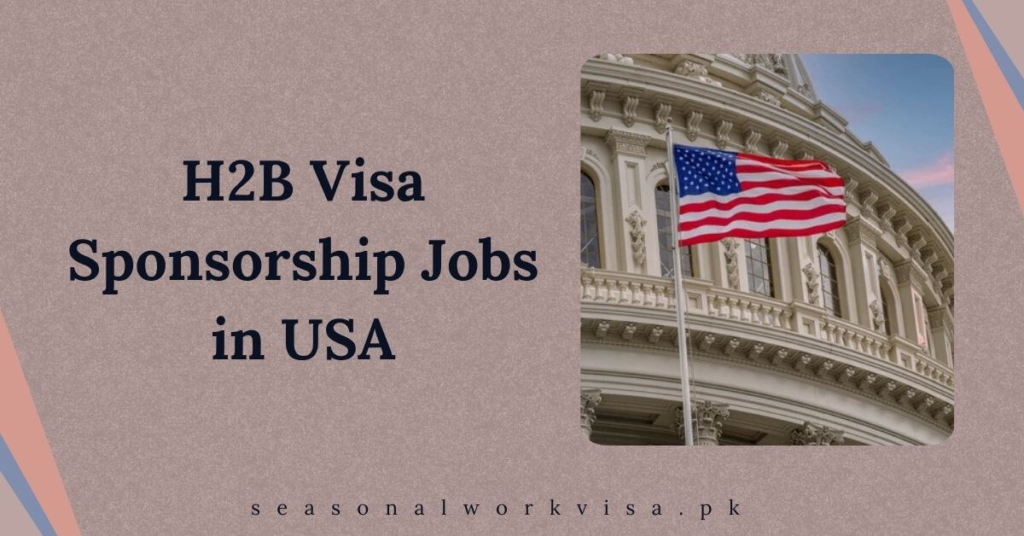📌 Introduction
The H2B visa program allows U.S. employers to hire foreign workers for temporary, non-agricultural jobs. This visa is especially valuable for indu
stries such as hospitality, construction, landscaping, and forestry. Understanding the H2B visa sponsorship process and the types of jobs available can help workers and employers alike navigate the complexities of the U.S. immigration system.
This guide will explore the following key areas:
- What the H2B visa is
- Who qualifies for the H2B visa
- The process for applying for H2B visa sponsorship jobs
- Types of jobs available for H2B workers
- How employers can sponsor foreign workers on an H2B visa
- Tips for success in securing H2B visa sponsorship
📌You May Also Like:
✅ Jobs in United States with VISA Sponsorship

📌 1: What is the H2B Visa?
The H2B visa is a non-immigrant visa designed for foreign workers seeking to fill temporary, non-agricultural jobs in the United States. Employers in industries with fluctuating seasonal or peak demands often require workers for jobs that cannot be filled by U.S. workers, and the H2B visa allows them to hire foreign workers.
Key Features of the H2B Visa:
- Temporary Nature: This visa is only valid for the length of the job offer, up to a maximum of 1 year, with the possibility of extending it up to 3 years.
- Job Requirements: The job must be temporary, and the need for foreign workers must be seasonal, peak load, or intermittent.
- Eligibility: Both the employer and the worker must meet specific eligibility requirements, which we’ll discuss later.
- Annual Cap: There is a cap on the number of H2B visas issued annually, typically 66,000, which is split into two halves: 33,000 for the first half of the fiscal year and 33,000 for the second half.
📌 2: Who Qualifies for the H2B Visa?
To qualify for the H2B visa, certain criteria must be met by both the worker and the employer.
Employer Eligibility
- Business Type: The employer must be in a non-agricultural business, such as hospitality, construction, landscaping, or manufacturing.
- Temporary Need: The employer must demonstrate a genuine need for foreign workers due to the temporary nature of the work. This need must be seasonal, peak load, or intermittent.
- Recruitment Efforts: Employers are required to prove that they made efforts to hire U.S. workers before resorting to foreign workers. This includes advertising the job and conducting interviews.
📌 Worker Eligibility
- Non-Immigrant Intent: Applicants must demonstrate that they intend to return to their home country after their temporary employment ends.
- Proof of Qualifications: Workers must meet the job qualifications and have the experience needed for the role.
- Background Check: Applicants may need to undergo a criminal background check and health examination.
📌 3: Types of Jobs Available for H2B Visa Holders
The H2B visa program is intended for temporary workers in a wide range of industries. Common sectors that hire H2B visa workers include:
Hospitality
- Hotels and Resorts: Positions such as housekeepers, chefs, waitstaff, and event coordinators are frequently available.
- Theme Parks: Seasonal jobs such as ride operators, maintenance workers, and entertainers are often offered during peak tourist seasons.
📌 Construction
- Laborers: Positions in general construction and specialized trades like carpenters, electricians, or painters are in high demand.
- Skilled Workers: Jobs for skilled workers such as concrete finishers and roofers may also be available.
Landscaping and Forestry
- Groundskeepers: Landscaping companies often seek seasonal workers for mowing lawns, planting, and maintaining landscapes.
- Forest Workers: There are opportunities in forest management, tree planting, and forest firefighting, especially in national parks or large forested areas.
Other Industries
- Agricultural Processing: Some H2B workers find roles in food processing or packaging plants.
- Amusement Parks: Positions for ride attendants, food service workers, and ticket sellers are common.
📌 4: How to Apply for H2B Visa Sponsorship Jobs
The process for securing an H2B visa involves several steps. Both the foreign worker and the employer have roles to play in the process.
Step 1: Employer Files a Labor Certification
Before applying for the H2B visa, the employer must first file a labor certification with the U.S. Department of Labor (DOL). This certification demonstrates that there is a shortage of U.S. workers willing to take the job and that the foreign worker will not negatively impact wages or working conditions for U.S. workers.
Step 2: Employer Files Petition
Once the labor certification is approved, the employer can file a petition (Form I-129) with U.S. Citizenship and Immigration Services (USCIS). The petition must include the approved labor certification and any other required documents, such as the worker’s qualifications and evidence of the job’s temporary nature.
Step 3: Worker Applies for the Visa
After the petition is approved, the worker can apply for the H2B visa at a U.S. embassy or consulate in their home country. This involves submitting the visa application (Form DS-160), attending an interview, and providing documents such as proof of employment and the approved petition.
Step 4: Enter the U.S.
If the visa is approved, the worker can travel to the U.S. and begin their employment.
📌 5: How Employers Can Sponsor H2B Workers
Labor Certification Process
Employers must demonstrate to the U.S. Department of Labor that their business needs temporary workers and that no qualified U.S. workers are available to fill these positions. Employers must advertise job openings, conduct interviews, and meet certain recruitment requirements before they can move forward with the petition process.
Filing the Petition
After receiving the labor certification, the employer can file the Form I-129 petition with USCIS, which includes the specifics of the job, the foreign worker’s qualifications, and evidence of the temporary nature of the work.
Following the Guidelines
Employers must adhere to wage regulations that ensure H2B workers are paid at least the prevailing wage for the position they are filling. Failure to comply with these regulations can result in penalties, fines, or loss of the ability to sponsor workers.
📌You May Also Like:
✅ Visa Sponsorship Your Ultimate Guide to Working Abroad

📌 6: Tips for Securing H2B Visa Sponsorship Jobs
For workers seeking H2B visa jobs, securing sponsorship can be challenging but is achievable with the right approach.
1. Research Employers and Industries
Understanding the industries and companies that most frequently hire H2B workers can increase your chances of finding job openings. Employers in hospitality, construction, and landscaping are among the biggest users of the H2B visa program.
2. Apply Early
The H2B visa cap can be reached quickly, so it’s important to apply as early as possible. Employers typically begin recruiting workers months before the season starts.
3. Demonstrate Your Skills
Having relevant experience and qualifications for the job increases your chances of securing an H2B job. If you are skilled in a particular trade, such as construction or culinary arts, highlight your experience when applying.
4. Stay Organized
Keep track of the visa application process, required documents, and deadlines. Ensuring everything is submitted correctly and on time can prevent delays.
📌 Conclusion
The H2B visa program provides a valuable opportunity for foreign workers to temporarily fill jobs in the U.S. while helping employers meet seasonal or peak demand. By understanding the qualifications, application process, and industries involved, workers and employers can effectively navigate the complexities of the program.
Whether you’re an employer seeking skilled workers or an individual interested in temporary work in the U.S., the H2B visa offers a path to gainful employment and experience in various sectors. By following the correct procedures and preparing adequately, securing an H2B visa sponsorship job is both achievable and rewarding.



